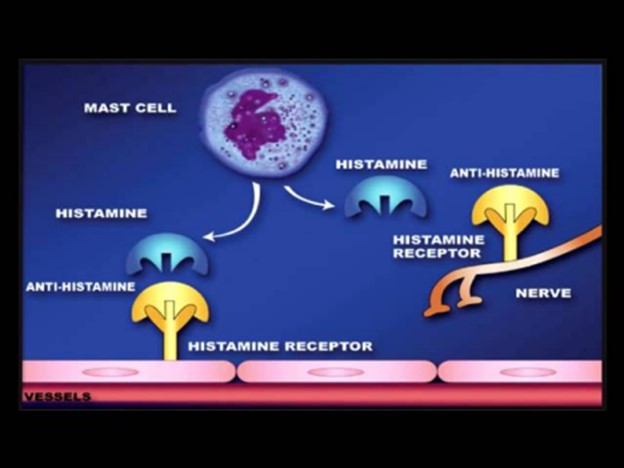A nursing instructor is teaching a group of nursing students about antihistamines. Which statement by a student indicates an understanding of the mechanism of action of the antihistamines?
"Antihistamines block release of histamine from mast cells and basophils."
"Antihistamines block H1 receptors to prevent actions of histamine at these sites."
"H1 antagonists can bind to H1 receptors, H2 receptors, and muscarinic receptors."
"First-generation antihistamines are more selective than second-generation antihistamines."
The Correct Answer is B
Antihistamines primarily work by blocking the H1 receptors, which are the receptors responsible for mediating the actions of histamine in the body. By blocking these receptors, antihistamines prevent or reduce the effects of histamine, such as itching, sneezing, runny nose, and watery eyes. This is the main mechanism by which antihistamines provide their therapeutic effects. "Antihistamines block release of histamine from mast cells and basophils." This statement is incorrect. Antihistamines do not block the release of histamine; instead, they block the histamine receptors to prevent the effects of histamine.
"H1 antagonists can bind to H1 receptors, H2 receptors, and muscarinic receptors." This statement is incorrect. H1 antagonists, or H1 receptor blockers, specifically bind to H1 receptors and do not have significant affinity for H2 receptors or muscarinic receptors. "First-generation antihistamines are more selective than second-generation antihistamines." This statement is incorrect. First-generation antihistamines are generally less selective and can have more sedating and anticholinergic effects compared to second-generation antihistamines, which are designed to be more selective for H1 receptors and have reduced sedative properties.

Nursing Test Bank
Naxlex Comprehensive Predictor Exams
Related Questions
Correct Answer is C
Explanation
A low-pressure ventilator alarm indicates a potential issue with the delivery of adequate air or pressure from the ventilator. The pulse oximetry reading of 85% suggests that the client is not receiving sufficient oxygenation.
Providing ventilation with a bag-valve-mask device allows the nurse to manually assist the client's breathing and ensure proper oxygenation and ventilation while troubleshooting the ventilator alarm. By manually ventilating the client, the nurse can help maintain oxygenation and prevent further hypoxemia until the underlying cause of the alarm can be identified and resolved.
Suctioning the client's endotracheal tube, adding air to the pilot balloon, or placing a bit block in the client's mouth may be appropriate interventions in specific situations, but they are not the immediate priority in this case. The primary concern is to address the low oxygen saturation and ensure adequate ventilation.
Correct Answer is ["A","D","E"]
Explanation
The teaching that the nurse will provide to the Patient Care Technician (PCT) when delegating ambulation for a client includes:
● "Please let me know how the client does after each ambulation": This instruction ensures that the PCT communicates any relevant information or changes observed during or after the ambulation, allowing the nurse to stay informed about the client's condition.
● "Be certain to use a gait belt when performing this activity": Using a gait belt is an important safety measure during ambulation. It helps provide support and stability for the client and allows the PCT to maintain control and assist in case the client becomes unsteady or falls.
● "Each ambulation should last 10 minutes": Providing a specific time frame for the ambulation helps guide the PCT in determining the duration of the activity. This ensures consistency in the care provided and allows for proper scheduling of ambulation throughout the day.
The other options provided ("Ambulate the client every four hours," "Come and get me for lunch") do not pertain to specific instructions or teaching related to the delegated ambulation task. The frequency of ambulation and the PCT's lunch break are not relevant to the teaching for this specific task.
Whether you are a student looking to ace your exams or a practicing nurse seeking to enhance your expertise , our nursing education contents will empower you with the confidence and competence to make a difference in the lives of patients and become a respected leader in the healthcare field.
Visit Naxlex, invest in your future and unlock endless possibilities with our unparalleled nursing education contents today
Report Wrong Answer on the Current Question
Do you disagree with the answer? If yes, what is your expected answer? Explain.
Kindly be descriptive with the issue you are facing.
